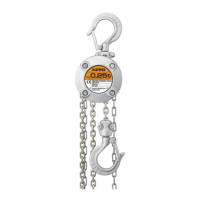7
Operation
Do not use the chain hoist in the following manners.
Failure to comply with these instructions may result in death or severe injury.
<General>
- The Load Chain is exclusively designed for this model of chain hoist. Do not use chains of other models of chain hoist.
Ensure that a competent person replaces the chain with an authorized part for this model, referring to Disassembly/Reassembly
Manual.
- Operate the chain hoist using only manual force.
- Do not leave a lifted load unattended for an extended period.
<Slinging>
- Do not use a Hook without a Latch.
- Do not apply a load to the tip of the hook or latch.
<Fig. A>
- Do not use the load chain as a sling. <Fig. B>
- Do not operate the load chain while it is in contact with any
sharp edges, e.g. of a steel plate. <Fig. C>
<Lifting>
- Do not lift more than the rated load. <Fig. D>
- Do not cause the load to come into contact with the load or
hand chains.
- Do not lift the load while holding the load chain.
- Do not swing the lifted load.
- Do not use the chain hoist without a straight line present
between the top and bottom hooks relative to the load direction. <Fig. E>
- Do not swing the load when lifting it off the ground. <Fig. F>
- In the situation where the chain hoist is to be used as a sling by connecting it to a crane, be
certain to convey the fact of this intended usage to KITO beforehand to confirm whether this
type of use is possible.
- Do not impede the hand chain with a lifted load or a member of the structure caught on the
chain.
- Do not use the chain hoist as a fulcrum. <Fig. G>
- When lifting off a load from a pallet, lift the load to avoid
exposing to shock, such as the load falling. <Fig. H>
- Do not lift or lower excessively.
- Before use, confirm the minimum distance between the
hook and load (minimum headroom) and lift in technical
data.
- Do not repeatedly operate the overload limiter (slipping action).
- If the overload limiter is activated, stop the lifting operation immediately and ensure that the chain hoist is in a no load state.
(Continued on the following page)
Prohibited
A
Overload
B C
D
E
F
G
H

